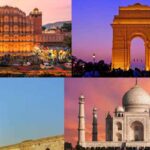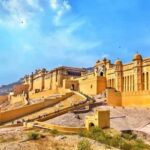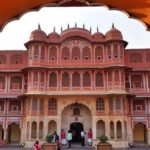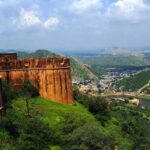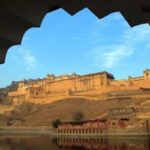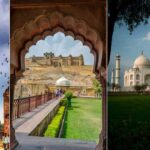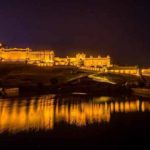Jaipur Tourism, also known as the “Pink City,” is the capital city of the Indian state of Rajasthan. It is one of the most popular tourist destinations in India, renowned for its rich history, magnificent forts, stunning palaces, vibrant culture, and colorful markets. Here’s a guide to tourism in Jaipur:
Amber Fort (Amer Fort): This majestic fort is located on a hilltop and is known for its impressive architecture and stunning views of the surrounding landscape. It features a blend of Rajput and Mughal architectural styles and is made of red sandstone and marble. The fort also has a light and sound show in the evening that narrates the history of Amber Fort, Jaipur Tour Packages.
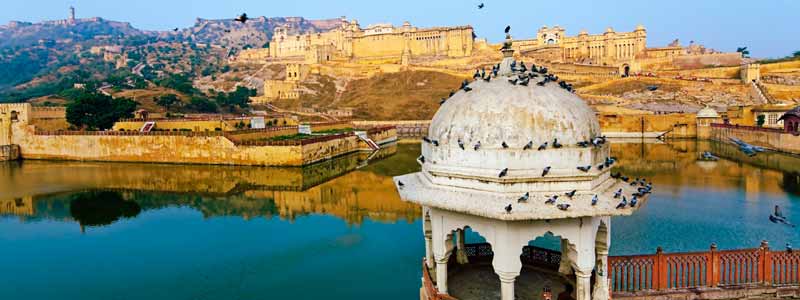
Amber Fort Jaipur
Amber Fort, also known as Amer Fort, is a magnificent fort located in Amer, a town situated about 11 kilometers from Jaipur, the capital city of Rajasthan, India. Amber Fort is one of the most popular tourist attractions in Jaipur and is known for its splendid architecture, rich history, and stunning panoramic views.
History: Amber Fort was built in the 16th century by Raja Man Singh I, a Rajput king of the Kachwaha dynasty. Over the years, the fort was expanded and renovated by various rulers, including Raja Jai Singh I and Raja Jai Singh II. It served as the main residence of the Rajput rulers of Amber for many years before the capital was shifted to Jaipur.
Architecture: Amber Fort is a blend of Rajput and Mughal architectural styles, reflecting the cultural fusion that existed during the reign of the Rajputana rulers. The fort is built using red sandstone and marble, and its impressive structure is a fine example of Rajput military architecture. It has massive walls, imposing gates, and numerous courtyards, palaces, and temples within its complex. Some of the key attractions of Amber Fort include the Diwan-i-Aam (Hall of Public Audience), Diwan-i-Khas (Hall of Private Audience), Sheesh Mahal (Mirror Palace), Sukh Niwas (Hall of Pleasure), and Ganesh Pol (Elephant Gate).
Elephant Rides: One of the unique experiences of visiting Amber Fort is the option to take an elephant ride from the foothills to the fort. The elephants are decorated with traditional attire, and the ride up the steep slope of the fort is a memorable experience. However, it’s important to note that there are ethical concerns associated with elephant rides, and it’s crucial to choose operators that follow responsible practices and ensure the well-being of the animals.
Light and Sound Show: Amber Fort also hosts a spectacular light and sound show in the evenings that narrates the history and legends associated with the fort. The show is a fascinating way to learn about the heritage of Amber Fort and its significance in Rajasthan’s history.
Visiting Amber Fort: Amber Fort is open to visitors throughout the year, and it is advisable to visit during the cooler months of October to March to avoid the scorching heat of Rajasthan’s summers. The fort can be reached by road, and there is ample parking available near the entrance. It’s important to wear comfortable clothing, carry a hat, sunglasses, and sunscreen, and stay hydrated during the visit, as the fort can be quite extensive to explore.
Amber Fort is a magnificent example of Rajputana architecture and a treasure trove of history and culture. It offers a fascinating glimpse into the opulent lifestyle of the Rajput rulers and is a must-visit destination for travelers to Jaipur and Rajasthan.
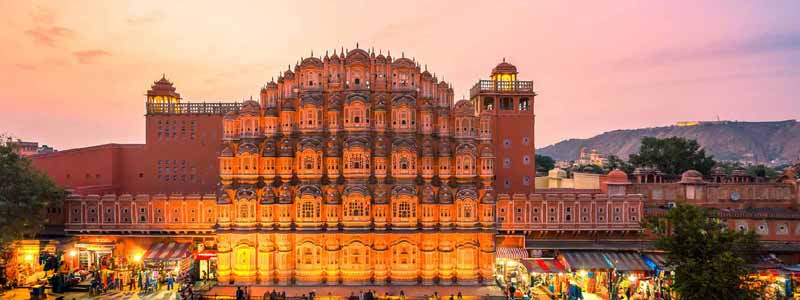
Hawa Mahal jaipur
Hawa Mahal, also known as the “Palace of Winds,” is a famous tourist attraction located in Jaipur, Rajasthan, India. It is an iconic landmark of Jaipur and a must-visit for tourists.
History: Hawa Mahal was built in 1799 by Maharaja Sawai Pratap Singh, who was the grandson of Maharaja Sawai Jai Singh II, the founder of Jaipur. It was designed by Lal Chand Usta, an architect in the Rajput style of architecture. The main purpose of building Hawa Mahal was to provide a place for the royal ladies to observe the street activities and festivals while maintaining their privacy, as they were not allowed to appear in public without covering their faces.
Architecture: Hawa Mahal is a five-story palace made of pink and red sandstone, which gives it its distinctive pink hue. It has a unique facade with intricately carved windows, balconies, and jharokhas (projecting enclosed balconies). The facade resembles a honeycomb or a beehive, with 953 small windows known as jharokhas, which are adorned with intricate lattice work, stone carvings, and floral patterns. The jharokhas are designed in a way that allows cool air to pass through, providing natural ventilation and air conditioning to the palace, hence the name “Palace of Winds.”
Highlights: The main attraction of Hawa Mahal is its unique architecture and facade, which is a masterpiece of Rajput craftsmanship. The palace offers stunning views of the city and its bustling streets from the jharokhas, making it a perfect spot for photography. The soft breeze that flows through the windows gives a soothing experience, and you can imagine the royal ladies observing the outside world from behind the screens.
Visiting Hawa Mahal: Hawa Mahal is located in the heart of Jaipur, and it is easily accessible by taxi, auto-rickshaw, or public transport. The palace is open for visitors from morning to evening, and there is an entry fee for foreigners and Indians. You can explore the different floors and get a glimpse of the royal lifestyle of the bygone era. There are also informative displays and exhibits inside the palace that provide insights into the history and architecture of Hawa Mahal.
Tips: To make the most of your visit to Hawa Mahal, it is recommended to visit during the early morning or late afternoon when the light is soft, and the weather is pleasant. The palace can get crowded, so visiting during weekdays or shoulder seasons may be less crowded. Wear comfortable footwear as you may need to climb stairs to explore the different floors of the palace.
Hawa Mahal is a unique architectural gem that reflects the rich heritage of Jaipur and Rajasthan. A visit to this iconic palace is a must for anyone traveling to Jaipur to experience its history, culture, and architectural marvels.
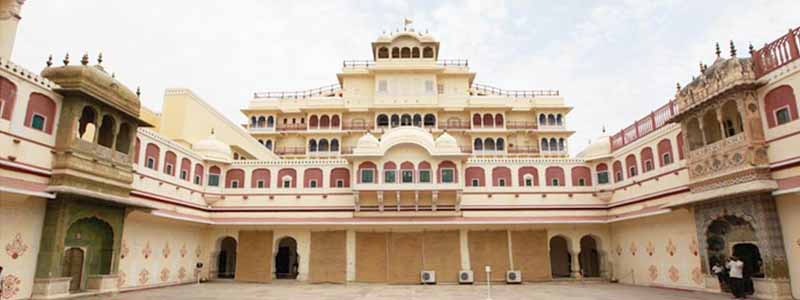
City Palace jaipur
The City Palace is one of the most famous tourist attractions in Jaipur, Rajasthan, India. It is a magnificent palace complex that showcases the rich history, culture, and architecture of Jaipur, and is a must-visit for tourists.
History: The City Palace was built by Maharaja Sawai Jai Singh II, the founder of Jaipur, in the 18th century. It served as the royal residence of the Jaipur royal family for many generations. The palace was later expanded and renovated by successive rulers, adding to its grandeur and architectural beauty.
Architecture: The City Palace is a stunning blend of Rajput, Mughal, and European architectural styles. The palace complex is spread over a vast area and comprises several courtyards, buildings, gardens, and temples. It is built using pink and red sandstone, which is characteristic of Jaipur’s architecture, and features intricate carvings, frescoes, and marble inlays.
Highlights: The City Palace is known for its opulent architecture, beautiful courtyards, and exquisite details. Some of the main attractions within the palace complex are:
- Chandra Mahal: This is the main palace building, which is still inhabited by the royal family. It is a seven-story structure with beautiful courtyards, stunning halls, and a museum showcasing the royal artifacts and collections.
- Mubarak Mahal: This is a beautiful building that now houses the textile museum, displaying an impressive collection of royal costumes, textiles, and carpets.
- Diwan-i-Khas: This is the Hall of Private Audience, which is adorned with intricate mirror work, gold leaf, and beautiful frescoes. It was used by the royal family for private meetings and functions.
- Diwan-i-Aam: This is the Hall of Public Audience, which was used by the rulers to address the public. It is known for its beautifully painted ceilings and elaborate arches.
- Peacock Gate: This is a stunningly beautiful gate adorned with peacock motifs and is one of the most famous entrances of the City Palace.
Visiting City Palace: The City Palace is located in the heart of Jaipur and is easily accessible by taxi, auto-rickshaw, or public transport. It is open for visitors throughout the year, and there is an entry fee for foreigners and Indians. Guided tours are available, which provide insights into the history, culture, and architecture of the palace. You can also witness the art and craft demonstrations, traditional music and dance performances, and enjoy the picturesque gardens within the palace complex.
Tips: The City Palace can get crowded, so it is recommended to visit early in the morning or late afternoon for a more peaceful experience. Dress modestly and respectfully, as it is a place of historical and cultural significance. Photography is allowed, but some areas may have restrictions, so it’s advisable to check beforehand. Wear comfortable footwear as there may be some walking and climbing involved.
A visit to the City Palace is a journey into the royal past of Jaipur, offering a glimpse of its rich heritage, grand architecture, and regal lifestyle. It is a must-visit destination for history, culture, and architecture enthusiasts visiting Jaipur.
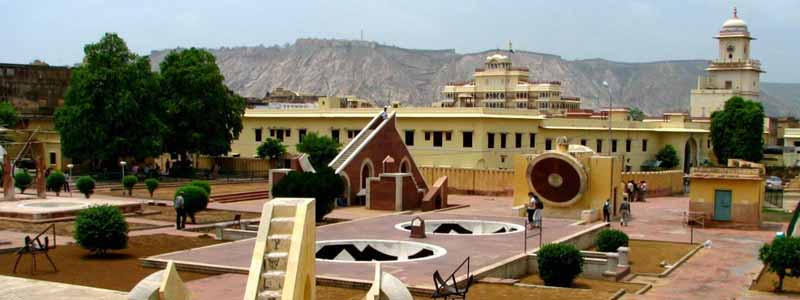
Jantar Mantar Jaipur
Jantar Mantar is a UNESCO World Heritage Site and a famous astronomical observatory located in Jaipur, Rajasthan, India. It is one of the five Jantar Mantars built by Maharaja Sawai Jai Singh II, the founder of Jaipur, in the 18th century, and is considered one of the largest and best-preserved observatories in the world.
History: Jantar Mantar was built by Maharaja Sawai Jai Singh II in 1734-1735, with the purpose of observing and studying celestial objects and making accurate astronomical calculations. Jai Singh II, who was an avid astronomer and mathematician, designed and constructed Jantar Mantar using advanced architectural and scientific principles of the time.
Architecture: Jantar Mantar is a fascinating example of ancient Indian astronomy and architecture. It comprises a collection of 19 large astronomical instruments, including massive masonry instruments, each serving a specific purpose, such as measuring time, tracking celestial bodies, determining the position of stars and planets, and predicting eclipses. The instruments are made of stone and marble, and some of them are incredibly large, reaching up to 90 feet in height.
Highlights: Some of the notable instruments at Jantar Mantar are:
- Samrat Yantra: Also known as the “Supreme Instrument,” it is the largest sundial in the world and can accurately measure time to within 2 seconds.
- Jai Prakash Yantra: This instrument consists of two hemispherical bowls with markings that allow astronomers to determine the position of celestial bodies and study eclipses.
- Ram Yantra: It is a massive, cylindrical instrument with a staircase that allows astronomers to reach the top for observations.
- Misra Yantra: This instrument is used to determine the shortest and longest days of the year.
Visiting Jantar Mantar: Jantar Mantar is located in the heart of Jaipur and is easily accessible by taxi, auto-rickshaw, or public transport. It is open for visitors throughout the year, and there is an entry fee for foreigners and Indians. Guided tours are available, which provide detailed explanations about the instruments and their functioning. It is advisable to visit during daylight hours to fully appreciate the instruments and their intricacies.
Tips: Jantar Mantar is a historical and scientific site, so it’s important to maintain respect and avoid touching or tampering with the instruments. Wear comfortable footwear and carry sun protection, as the site is mostly outdoors and can get hot during the day. Photography is allowed, but be mindful of any restrictions and guidelines. A visit to Jantar Mantar is a unique experience, offering insights into the scientific and astronomical knowledge of ancient India and the architectural marvels of the past.
Overall, Jantar Mantar is a must-visit destination for history, science, and architecture enthusiasts, providing a glimpse into the rich heritage and scientific advancements of Jaipur and India.
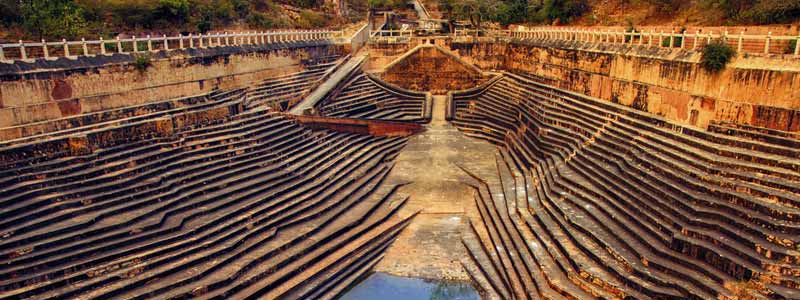
Nahargarh Fort Jaipur
Nahargarh Fort is a historic fort located in Jaipur, Rajasthan, India. It is one of the three forts of Jaipur, along with Amber Fort and Jaigarh Fort, and is situated on the Aravalli Hills overlooking the city of Jaipur. Nahargarh Fort is known for its stunning views of Jaipur’s skyline, its beautiful architecture, and its historical significance.
History: Nahargarh Fort was built in 1734 by Maharaja Sawai Jai Singh II, the founder of Jaipur. Originally, it was known as Sudarshangarh Fort, but it was later renamed Nahargarh Fort, which means “abode of tigers,” as it was believed to be haunted by the spirit of a Rathore prince named Nahar Singh. The fort was used as a retreat and hunting lodge by the royal family of Jaipur, and it also served as a defensive structure to protect the city.
Architecture: Nahargarh Fort is built in the traditional Rajput architectural style, with strong fortifications, thick walls, and bastions. The fort is made of red sandstone and offers panoramic views of Jaipur city and its surrounding landscapes. The fort has several structures within its complex, including palaces, courtyards, temples, and gardens. Some of the notable structures at Nahargarh Fort are Madhavendra Bhawan, Diwan-i-Aam, Diwan-i-Khas, and Nahargarh Biological Park.
Highlights: Nahargarh Fort is known for its picturesque views of Jaipur city, especially during sunset and sunrise. The fort offers stunning vistas of the city’s iconic landmarks, such as Hawa Mahal, Jantar Mantar, and the Jaipur cityscape. The Madhavendra Bhawan, which was a summer palace for the royal family, is a major highlight of the fort. It consists of a series of interconnected suites with colorful frescoes, providing a glimpse into the royal lifestyle of the past. The fort also has a restaurant called Padao, which offers a unique dining experience with panoramic views of Jaipur.
Visiting Nahargarh Fort: Nahargarh Fort is easily accessible by road from Jaipur city, and there is a road that leads directly to the fort. The fort is open for visitors throughout the year, and there is an entry fee for foreigners and Indians. Guided tours are available, which provide insights into the history and architecture of the fort. It is advisable to visit during the cooler hours of the day, such as early morning or late afternoon, to fully enjoy the views and explore the fort.
Tips: Wear comfortable footwear as there is some walking involved within the fort complex. Carry water, sunscreen, and a hat, as the fort can get hot during the day, especially during summers. Respect the heritage and history of the fort by not littering or damaging any structures. Photography is allowed, but be mindful of any restrictions and guidelines.
Nahargarh Fort is a popular tourist destination in Jaipur, offering a mix of history, architecture, and panoramic views. It is a must-visit place for travelers interested in Rajput history, fort architecture, and stunning vistas of Jaipur city.
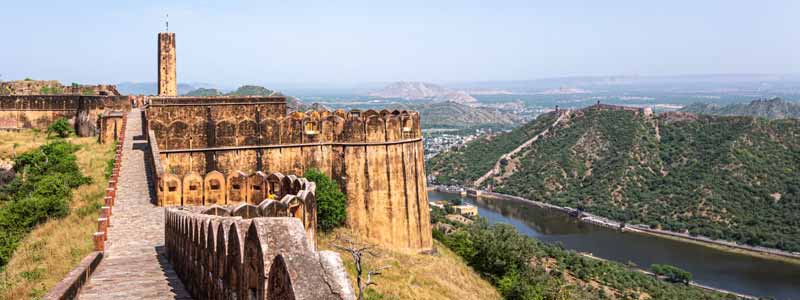
Jaigarh Fort Jaipur
Jaigarh Fort is a historic fort located in Jaipur, Rajasthan, India. It is one of the three forts of Jaipur, along with Amber Fort and Nahargarh Fort, and is situated on the Aravalli Hills overlooking the Amber Fort and Maota Lake. Jaigarh Fort is known for its impressive fortifications, ancient weapons, and stunning views of the surrounding landscape.
History: Jaigarh Fort was built in 1726 by Maharaja Sawai Jai Singh II, the founder of Jaipur. It was originally built as a defensive structure to protect the Amber Fort and the royal family of Jaipur. The fort was also used to store weapons, ammunition, and treasures of the royal family. Over the years, Jaigarh Fort served as an important military outpost and played a significant role in the history of Rajasthan.
Architecture: Jaigarh Fort is built in the traditional Rajput architectural style, with thick walls, ramparts, and bastions. The fort is made of red sandstone and spreads over a large area, with multiple structures within its complex. Some of the notable structures at Jaigarh Fort are the Jaivana Cannon, Vijay Garh Palace, Diya Burj, and the Museum.
Highlights: Jaigarh Fort is known for its massive cannon called Jaivana, which is considered to be the world’s largest cannon on wheels. The fort also houses a museum that displays various artifacts, weapons, and ancient manuscripts, providing insights into the history and culture of Rajasthan. The Vijay Garh Palace, located within the fort, is known for its impressive architecture and stunning views of the surrounding landscape, including the Amber Fort and Maota Lake. The fort also offers panoramic views of Jaipur city and its surrounding areas, making it a great spot for photography and enjoying the scenic beauty of the region.
Visiting Jaigarh Fort: Jaigarh Fort is easily accessible by road from Jaipur city, and there is a road that leads directly to the fort. The fort is open for visitors throughout the year, and there is an entry fee for foreigners and Indians. Guided tours are available, which provide insights into the history and architecture of the fort. It is advisable to visit during the cooler hours of the day, such as early morning or late afternoon, to fully enjoy the views and explore the fort.
Tips: Wear comfortable footwear as there is some walking involved within the fort complex. Carry water, sunscreen, and a hat, as the fort can get hot during the day, especially during summers. Respect the heritage and history of the fort by not littering or damaging any structures. Photography is allowed, but be mindful of any restrictions and guidelines Jaipur Tourism.
Jaigarh Fort is a fascinating historical site in Jaipur that offers a glimpse into the rich history and culture of Rajasthan. It is a must-visit place for travelers interested in fort architecture, ancient weapons, and panoramic views of the landscape.
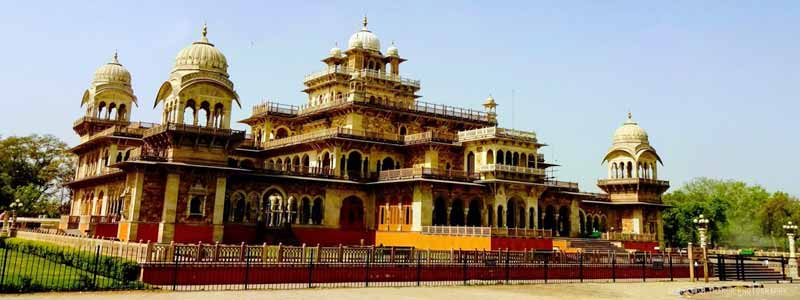
Albert Hall Museum Jaipur
Albert Hall Museum is a popular museum located in Jaipur, Rajasthan, India. It is one of the oldest museums in the state and is known for its rich collection of artifacts, including paintings, sculptures, textiles, arms and armor, and more. The museum is housed in a stunning building, which is a fine example of Indo-Saracenic architecture and is a prominent landmark in Jaipur.
History: Albert Hall Museum was inaugurated in 1887 by the Prince of Wales, Albert Edward, during his visit to Jaipur. It was designed by Sir Samuel Swinton Jacob, a British architect, and is named after the Prince of Wales, who later became King Edward VII. The museum was established with the objective of providing education and promoting art, culture, and history of Rajasthan.
Architecture: The building that houses the Albert Hall Museum is a magnificent structure, designed in Indo-Saracenic architectural style, which is a blend of Indian, Islamic, and British architectural elements. The museum building is made of sandstone and is adorned with intricate carvings, domes, and arches. The central dome of the museum is particularly impressive and is a prominent feature of its architecture. The museum also has a beautiful garden surrounding the building, which adds to its charm.
Collection: Albert Hall Museum has a rich and diverse collection of artifacts that showcase the art, culture, and history of Rajasthan. The museum has various galleries displaying artifacts such as paintings, sculptures, pottery, textiles, jewelry, arms and armor, and more. Some of the highlights of the museum’s collection include an Egyptian mummy, miniature paintings from the Rajput and Mughal era, sculptures from various periods, and a collection of traditional Rajasthani costumes and jewelry.
Activities: Apart from admiring the artifacts on display, visitors to Albert Hall Museum can also engage in various activities. The museum conducts workshops, lectures, and educational programs to promote art, culture, and history. There are also cultural performances and events organized at the museum, providing a glimpse into the rich cultural heritage of Rajasthan.
Visiting Albert Hall Museum: The museum is located in the heart of Jaipur city and is easily accessible by road. It is open for visitors throughout the year, and there is an entry fee for foreigners and Indians. Photography is allowed inside the museum, but it is advisable to check for any specific guidelines or restrictions. Guided tours are available, which provide insights into the history and significance of the artifacts on display Jaipur Tourism.
Tips: Plan to spend a few hours at the museum to fully explore its diverse collection. Wear comfortable footwear as there is some walking involved within the museum complex. Carry water and sunscreen, as the museum can get hot during the day, especially during summers. Respect the artifacts and the rules of the museum by not touching or damaging any exhibits.
Albert Hall Museum is a treasure trove of art, culture, and history, and is a must-visit destination for travelers interested in exploring the rich heritage of Rajasthan. It offers a fascinating glimpse into the diverse artistic and cultural traditions of the region and is a treat for history and art enthusiasts alike.
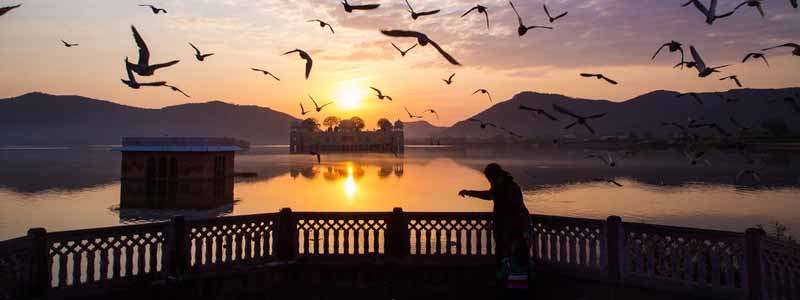
Jal Mahal Jaipur
Jal Mahal, also known as the Water Palace, is a beautiful palace located in the middle of Man Sagar Lake in Jaipur, Rajasthan, India. It is one of the most iconic landmarks of Jaipur and is known for its stunning architecture, serene surroundings, and rich history.
History: Jal Mahal was built in the 18th century by Maharaja Madho Singh I of the Kachwaha Rajput dynasty. The palace was originally used as a hunting lodge and summer retreat for the royal family. It was later renovated and expanded by Maharaja Jai Singh II, the founder of Jaipur, to its current grandeur. Over the years, the palace has been used for various purposes and has undergone multiple restorations to preserve its architectural beauty.
Architecture: The Jal Mahal is a classic example of Rajput and Mughal architectural styles. The palace is a five-story structure, with four floors submerged in water when the lake is full. The top floor of the palace is exposed and showcases a blend of Rajput and Mughal architectural elements, including intricate stone carvings, arched windows, and decorative chhatris (domed pavilions). The palace is made of red sandstone and has a symmetrical design with octagonal towers at each corner, adding to its visual appeal.
Surroundings: The Jal Mahal is located in the middle of the Man Sagar Lake, which is surrounded by picturesque hills and offers stunning views of the Aravalli Range. The tranquil surroundings of the lake make it a perfect spot for nature lovers and photography enthusiasts. The palace is also a popular spot for birdwatching, as the lake is home to various migratory and resident bird species.
Boat Rides: Visitors can enjoy boat rides in traditional Rajasthani-style wooden boats called “kishti” to get a closer view of the Jal Mahal. The boat rides offer a unique perspective of the palace and its surrounding landscape, making it a memorable experience.
Visiting Jal Mahal: The palace is located on Amer Road in Jaipur and is easily accessible by road. However, visitors are not allowed to enter the Jaipur Tourism as it is currently not open to the public for interior exploration. Nevertheless, the exterior of the palace and the picturesque views of the lake and hills make it a popular tourist spot for photography and leisurely walks.
Tips: It is advisable to visit Jal Mahal during the early morning or late afternoon to avoid the crowds and to capture the best photographs. Carry a hat, sunglasses, and sunscreen as the area around the lake can get hot during the day, especially in summers. Be cautious while taking boat rides and follow the safety guidelines provided by the boat operators.
Jal Mahal is a unique architectural marvel that offers a mesmerizing experience with its serene surroundings and stunning views. It is a must-visit destination for travelers to Jaipur who are interested in history, architecture, and natural beauty.
Apart from these popular attractions, Jaipur also hosts colorful festivals like Diwali, Holi, and the famous Jaipur Literature Festival, which draws literary enthusiasts from all over

